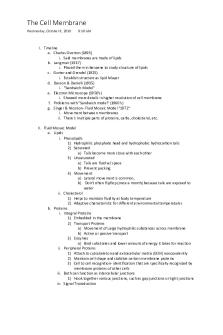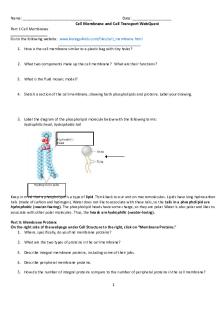Exercise 1 Construction OF CELL Membrane Capuno PDF

| Title | Exercise 1 Construction OF CELL Membrane Capuno |
|---|---|
| Author | Lionel Jane Capuno |
| Course | Biology 1 |
| Institution | Mindanao State University |
| Pages | 2 |
| File Size | 99.1 KB |
| File Type | |
| Total Downloads | 81 |
| Total Views | 156 |
Summary
Assignment...
Description
Name: Lionel Jane T. Capuno Section: Animal Biology Block A (B2A12/B2A56)
Date: 11/15/2020 Score:
EXERCISE 1: Construction of Cell Membrane Instruction: Click this link for you to be able to study the structure of the cell membrane and construct it using the correct molecules (https://www.wisconline.com/learn/natural-science/lifescience/ap1101/construction-of-thecell-membrane). Once done, answer the following questions: a. Identify the following structures of a cell membrane
Pore Protein
Phospholipid s
Fibrous Protein
Glycoprotein
Channel protein
2. Refer to Question# 1, what structure forms the basic frame of the cell membrane? The structure that forms the basic frame of the cell membrane is the phospholipid bilayer. This bilayer composts of two components which are the lipids (forming the matrix of the membrane) and the proteins (the ones that are embedded in the membrane or attached to the surface of the membrane. In conclusion the answer would be phospholipids. 3. What is the function of the glycoprotein molecule in the cell membrane? Glycoproteins identify the cell. This means that it’s role is cell-to-cell recognition. 4. What molecules are found in animal cell membranes, but not in plant cell membranes? Cholesterol molecules are found in animal cell membranes, they are embedded in them. However, they are not present in plant cell membranes. 5. Which intermolecular process primarily drives the formation of a bilayer when phospholipids are added to water? Tick the appropriate box for your answer. [√ ] Lipids cause water to arrange in an ordered, unfavorable cage-like structure. Forcing lipids into a bilayer reduces this effect
[ ] Phospholipids self-assemble into a bilayer due to the strong affinity they have for each other. [ ] The ordered arrangement of a bilayer is more favorable than the disordered state of individual free-floating phospholipids. [ ] A bilayer arrangement maximizes the strength of Van der Waals forces among phospholipids....
Similar Free PDFs

Cell Membrane Coloring Worksheet
- 2 Pages

The Cell Membrane
- 2 Pages

6-cell membrane web quest
- 4 Pages

Ecampa lab report - cell membrane
- 14 Pages
Popular Institutions
- Tinajero National High School - Annex
- Politeknik Caltex Riau
- Yokohama City University
- SGT University
- University of Al-Qadisiyah
- Divine Word College of Vigan
- Techniek College Rotterdam
- Universidade de Santiago
- Universiti Teknologi MARA Cawangan Johor Kampus Pasir Gudang
- Poltekkes Kemenkes Yogyakarta
- Baguio City National High School
- Colegio san marcos
- preparatoria uno
- Centro de Bachillerato Tecnológico Industrial y de Servicios No. 107
- Dalian Maritime University
- Quang Trung Secondary School
- Colegio Tecnológico en Informática
- Corporación Regional de Educación Superior
- Grupo CEDVA
- Dar Al Uloom University
- Centro de Estudios Preuniversitarios de la Universidad Nacional de Ingeniería
- 上智大学
- Aakash International School, Nuna Majara
- San Felipe Neri Catholic School
- Kang Chiao International School - New Taipei City
- Misamis Occidental National High School
- Institución Educativa Escuela Normal Juan Ladrilleros
- Kolehiyo ng Pantukan
- Batanes State College
- Instituto Continental
- Sekolah Menengah Kejuruan Kesehatan Kaltara (Tarakan)
- Colegio de La Inmaculada Concepcion - Cebu











